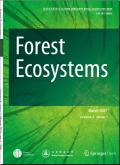Shrub height and crown projection area are effective predictors in aboveground biomass models for multi-stemmed European hazel
IF 4.4
1区 农林科学
Q1 FORESTRY
引用次数: 0
Abstract
While numerous allometric models exist for estimating biomass in trees with single stems, models for multi-stemmed species are scarce. This study presents models for predicting aboveground biomass (AGB) in European hazel (Corylus avellana L.), growing in multi-stemmed shrub form. We measured the size and harvested the biomass of 30 European hazel shrubs, drying and weighing their woody parts and leaves separately. AGB (dry mass) and leaf area models were established using a range of predictors, such as the upper height of the shrub, number of shoots per shrub, canopy projection area, stem base diameter of the thickest stem, and the sum of cross-sectional areas of all stems at the stem base. The latter was the best predictor of AGB, but the most practically useful variables, defined as relatively easy to measure by terrestrial or aerial approaches, were the upper height of the shrub and the canopy projection area. The leaf biomass to AGB ratio decreased with the shrub's height. Specific leaf area of shaded leaves increases with shrub height, but that of leaves at the top of the canopy does not change significantly. Given that the upper shrub height and crown projection of European hazel can be estimated using remote sensing approaches, especially UAV and LIDAR, these two variables appear the most promising for effective measurement of AGB in hazel.
灌木高度和树冠投影面积是多茎欧洲榛子地上生物量模型的有效预测因子
目前已有大量的异速生长模型用于估算单茎树种的生物量,但用于估算多茎树种生物量的模型却很少。本研究建立了多茎灌木型欧洲榛子(Corylus avellana L.)地上生物量(AGB)的预测模型。我们测量了30种欧洲榛子灌木的大小和生物量,分别干燥和称重它们的木质部分和叶子。利用灌木高度、每丛芽数、冠层投影面积、最粗茎的茎基部直径和茎基部所有茎的截面积总和等预测因子建立了干质量和叶面积模型。后者是AGB的最佳预测因子,但最实际有用的变量(定义为相对容易通过陆地或空中方法测量)是灌木的最高高度和冠层投影面积。叶片生物量与AGB比值随灌木高度的增加而降低。遮荫叶的比叶面积随灌木高度的增加而增加,而冠顶叶的比叶面积变化不显著。考虑到欧洲榛子上部灌木高度和树冠投影可以通过遥感方法估算,特别是无人机和激光雷达,这两个变量似乎是最有希望有效测量榛子AGB的变量。
本文章由计算机程序翻译,如有差异,请以英文原文为准。
求助全文
约1分钟内获得全文
求助全文
来源期刊

Forest Ecosystems
Environmental Science-Nature and Landscape Conservation
CiteScore
7.10
自引率
4.90%
发文量
1115
审稿时长
22 days
期刊介绍:
Forest Ecosystems is an open access, peer-reviewed journal publishing scientific communications from any discipline that can provide interesting contributions about the structure and dynamics of "natural" and "domesticated" forest ecosystems, and their services to people. The journal welcomes innovative science as well as application oriented work that will enhance understanding of woody plant communities. Very specific studies are welcome if they are part of a thematic series that provides some holistic perspective that is of general interest.
 求助内容:
求助内容: 应助结果提醒方式:
应助结果提醒方式:


